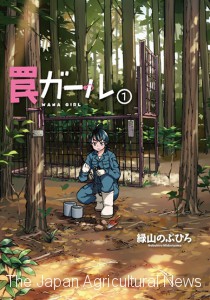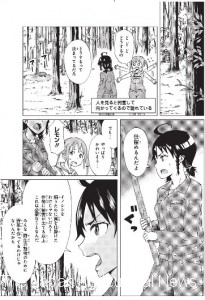TOKYO, Dec. 27 — A farm-grown high school girl’s battle against birds and animals – it’s the theme of a recent hit comic that runs in a Japanese manga magazine called “Dengeki Maoh” since May last year. The comic, “Wana Girl (School girl/animal trapper),” succeeded to get a following and came in a comic book on December 27, 2017.
Young people today buy fewer comics and manga magazines, and comic book circulation is falling dramatically. But this is not the case with the comics about farmers and the farm industry and some comics are making hits by focusing on rural farm life which used to be unpopular among young generations for being dirty, dangerous, and demanding.
“Wana Girl” is a story about a high school girl in a rural town and her battle against bird and animal damage on agricultural products. She has a hunting license for traps and tries to find the best way to limit the damage caused by wild animals. In one story, she caught a wild boar using a wire leghold trap she created. In another, she showed the courage to learn how to butcher a deer. All these episodes illustrate the real challenges of the farmers.
The author of “Wana Girl,” Nobuhiro Midoriyama, was born as a son of a farmer in Fukuoka Prefecture. He once worked in Tokyo as an assistant to a cartoonist, but after a while, he returned to Fukuoka to become a farmer. Like the girl in the comic, Midoriyama has a license to catch animals by traps, and in his real life, he also fights against birds and animals to protect rice and vegetables he grows. Then he draws his manga based on his own experience.
“We simply want to concentrate on farming, but in reality, we spend a lot of time in controlling animal damages. Due to a lack of licensed hunters, farmers need to have hunting licenses,” Midoriyama explained. “It’s only a cartoon, but hopefully, it can help us show the reality of farmers and make young people get more interested in agriculture. Then, I hope, they may start thinking of being a farmer or a hunter in the future,” he continued.
Gibier dishes made with wild animals are becoming increasingly more popular, but on the contrary, the lack of professional hunters has been a serious problem. Japan Hunters Association said, “The description about the relationship between living things and life is quite accurate. We hope this manga will make hunting interesting to young and female readers.”
Manga featuring middle traders of fruits and vegetables or wife of farmer also popular among manga fans
A manga featuring middle traders’ market has also been successful in winning followers. “Yaomori no Ely (Ely of Yaomori)” is a story of a young new middle trader named Eiri Uzuki (Ely) who found the job at an intermediate wholesaler named Yaomori in the Utsunomiya Wholesale Market. The story runs in a comic magazine called “Weekly Morning” since September 2017. The author, Lina Kojika, is a manga artist whose husband is an intermediate wholesaler, and her story is about the pleasure and the reality of workers at the wholesale market. Manga featuring a middle trader is also quite unusual.
“Green – Noka no yome ni naritai (Wanna be a wife of a farmer)” by Tomoko Ninomiya is another hit manga that caught the hearts of manga fans. It ran in a comic magazine targeting female readers of over 20s and was made into a TV drama in 2004. It’s a story of a city girl who fell in love with a young farmer from Chichibu, Saitama Prefecture, and went after him, uninvited, to help his farm in Saitama.



